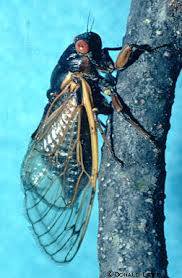
When the health department in Columbia, Mo., nixed a new flavor of ice cream laced with cicadas in early June from a local shop's menu, it wasn't because it's illegal to serve the winged insects to the public. "It's not really regulated," says Gerald Worley, the department's manager of environmental health, who adds, "I don't claim to be an expert on this." Nonetheless, Worley says he discouraged Sparky's Homemade Ice Cream proprietor Scott Southwick from selling the surprisingly popular flavor because Southwick "didn't really have a plan for how he would cook them," and Worley worried that the critters, which were collected from the ground, might make people sick. "We suggested that it would not be a good idea," says Worley. The first batch, in which the boiled bugs were covered with brown sugar and milk chocolate, then mixed in with an ice cream base of brown sugar and butter, had promptly sold out after the shop announced the flavor on its Facebook page.
As it turns out, cicadas have a long culinary history, and the emergence this spring of the noisy, 13-year-cyclical cricket-like insect in the Southeast and southern Midwest has brought a resurgence in cicada cuisine. Ashlee Horne of Nashville likes her cicadas sautéed in butter and garlic. Jenna Jadin of Washington, D.C., bakes them into banana bread, chocolate-chip cookies and rhubarb pie. Others like them dipped in chocolate for a sweet, crunchy snack. The inch-long bugs are widely consumed around the world, especially in East Asia, and are considered a delicacy among the Iroquois people in the U.S. Even the ancient Greek philosopher Aristotle gobbled them up: in his 4th century B.C. text Historia Animalium, he noted that the young nymphs are tastier than mature bugs, which have a harder exoskeleton, and that among adults, the egg-laden females are best. (See pictures of bug cuisine.)
So why all the fuss about eating cicadas today? "We make such a big deal out of this, but the biggest thing we have to deal with is human ignorance. They are no more germy than any other animal," says David George Gordon, author of The Eat a Bug Cookbook, who likes cicada nymphs as a pizza topping and says they have an asparagus-like flavor. Nymphs also have a chewy texture, while mature cicadas are crunchy and have more of a nutty taste, similar to that of peanuts or almonds. (See TIME's photo gallery of what the world eats.)
Entomologist Steve Murphree of Belmont University in Nashville says nymphs, which live underground for 13 years by sucking the sap of tree roots, are safe to eat raw after they emerge from the ground and shed their exoskeleton. Mature cicadas should be boiled while still alive to kill any bacteria, and already-dead cicadas should never be harvested because they could be decomposing. Also, anyone with allergies to shellfish, which belong to the same family as cicadas, should avoid the bugs altogether. (Read more about cicada ice cream.)
But bug eaters need to act fast. Once they emerge, the 13-year cicadas live for five weeks at most, according to Murphree. They can be found mostly on oak, hickory, apple and pear trees, where they lay their eggs. By the end of July, most of these so-called Brood XIX cicadas, also known as the Great Southern Brood, will have gone back underground. While the red-eyed bugs have already quieted down in Kentucky and Tennessee, the males' distinctive mating song is still piercingly loud in parts of Missouri and southern Illinois. (See the top 10 annoying sounds.)
But chances are you'll need to catch and cook them yourself, judging by the Columbia, Mo., health department's reaction to cicada ice cream. Good thing the Web is full of cicada recipes, along with tips on catching and preparing them. Meanwhile, the more timid among us can sit back and watch.
Source Time Magazine: http://www.time.com/time/nation/article/0,8599,2078830,00.html


